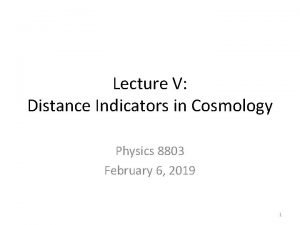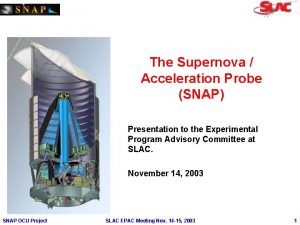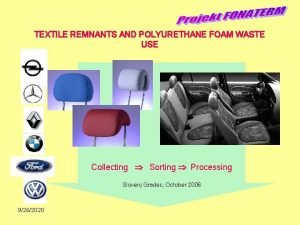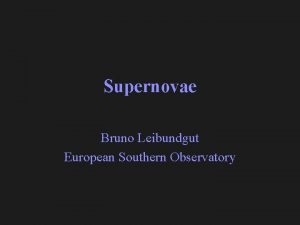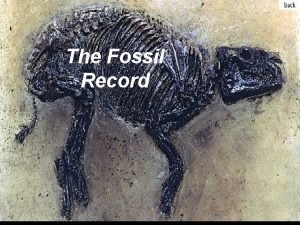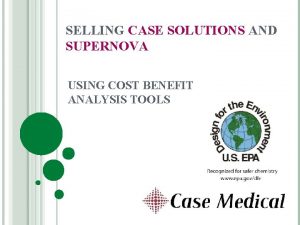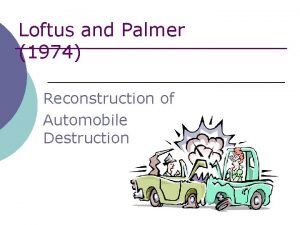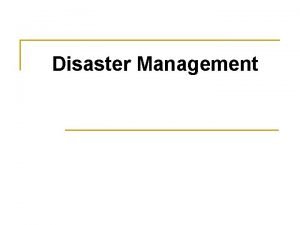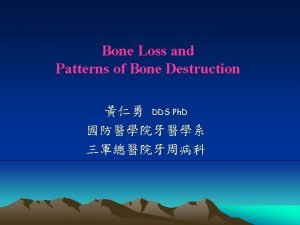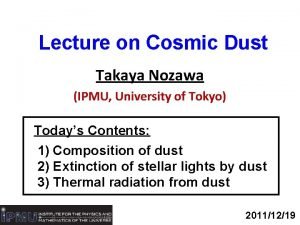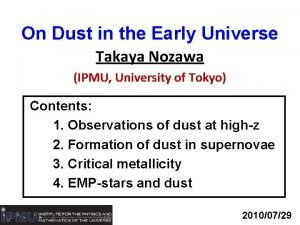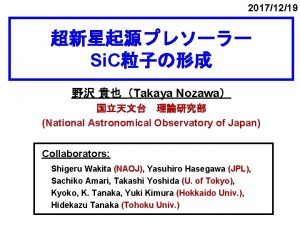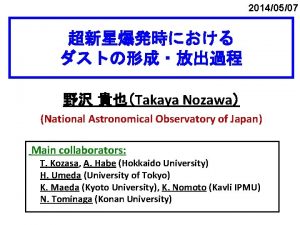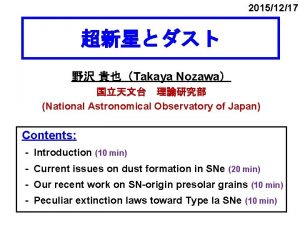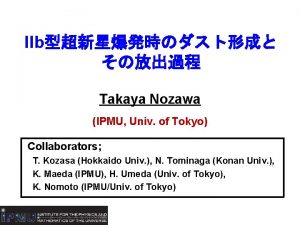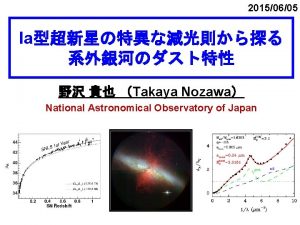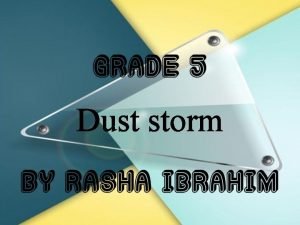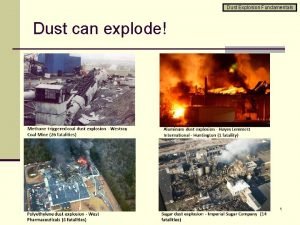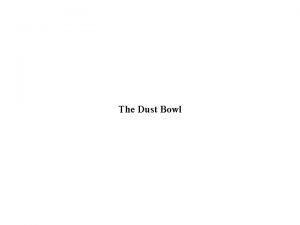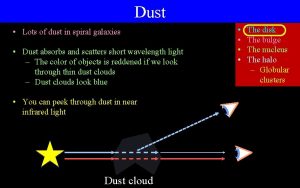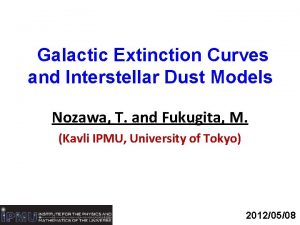20191107 Dust destruction in supernova remnants Takaya Nozawa


















- Slides: 18

2019/11/07 Dust destruction in supernova remnants Takaya Nozawa (National Astronomical Observatory of Japan)

Are core-collapse supernovae (CCSNe) dust producers or dust destroyers? SN 1987 A, submm ALMA, 870 µm ALMA, 450 µm HST optical (HI) Chandra, X-ray SN 1987 A, MIR Gemini T-Re. CS 10. 36 μm Bouchet+2004 Indebetouw+2014 Cool dust (~20 K) of ~0. 5 Msun formed in the ejecta Forward shock hits and destroys dust in equatorial ring Cas A, composite red : MIR Reverse and forward shocks, respectively, destroy the ejecta dust and interstellar dust

1 -1. Depletion of gas metals in the ISM 1 0. 1 O C Mg, Si: 90 -95 % Si Mg C, O: 30 -70 % 0. 01 0. 001 Fe: >99 % Fe Savage & Sembach (1996, ARAA, 34, 270)

1 -1. Depletion of gas metals in the ISM Most of refractory elements are locked up 1 in interstellar dust grains O Mg, Si: 90 -95 % C 0. 1 Dust-to-gas mass ratio : D ~ 0. 01 Si C, O: 30 -70 % of interstellar dust ➜ The abundance Mg 0. 01 is almost saturated Fe: >99 % Fe 0. 001 Formation and destruction processes of interstellar dust should be balanced out Savage & Sembach (1996, ARAA, 34, 270)

1 -2. Paradox of interstellar dust mass 〇 Injection rate of dust from CCSNe/AGB stars SFR = stellar death rate SNe 0. 006 Msun/yr Mass fraction Condensation Fraction of stars evolving of gas ejected efficiency of dust from SNe/AGB to SNe/AGB stars 〇 Destruction rate of interstellar dust by SN shocks 0. 004 M sun/yr SN rate Formation Gas mass swept by a SN shock Dust-to-gas mass ratio Destruction efficiency of dust rate of dust in stellar sources is lower than destruction rate of dust ➜ Interstellar dust must decrease with time

1 -3. What is wrong? 〇 Underestimate dust condensation efficiency - CCSNe eject ~10 Msun gas and ~0. 5 Msun dust fdust, form = 0. 05 ~90% of dust destroyed by reverse shocks fdust, form = 0. 005 (Mdust, form ~ 0. 05 Msun per SN) 〇 Overestimate dust destruction efficiency - Mdust, dest ~ 6 Msun per SN ~ 2000 Msun x 0. 01 x 0. 3 There is uncertainties in destruction efficiency 〇 Other sources of interstellar dust? - RGs, RSGs, s. AGB stars, LBVs, WR stars, novae, … - Grain growth in molecular clouds

2 -1. Observed dust mass in CCSNe/SNRs NIR/MIR FIR/submm extinction Balow+2010 Gomez+2012 Indebetouw+2014 Dust mass formed in the ejecta is dominated by cold dust

2 -1. Observed dust mass in CCSNe/SNRs Optical depth effects? Dust mass increasing with time? NIR/MIR FIR/submm extinction Tanaka, TN, et al. (2012, Ap. J, 749, 173) Dust mass formed in the ejecta is dominated by cold dust

2 -2. Mass of SN dust increases with time? Gall+2014, Nature Dust formed in cool dense shell Dust formed in the ejecta Pre-existing circumstellar dust (Van Dyk 2013) The mass of newly formed dust increases with time? We should not discuss the mass of newly formed grains by integrating the formation of dust in the ejecta and CDS

2 -3. Timescale of grain growth At 20 yr, the gas density is too low to form dust grains in the freely expanding ejecta

2 -4. Optical depth effects? Apparent dust mass from IR emission optically thick optically thin Dwek+2019 - Dust formation can be completed until a few years - The apparent increase in dust mass may be due to opacity effects of dust thermal emission

3 -1. Observed dust mass in CCSNe/SNRs reverse shock destruction ? ? Optical depth effects? Dust mass increasing with time? ? ? NIR/MIR FIR/submm extinction Tanaka, TN, et al. (2012, Ap. J, 749, 173) Dust mass formed in the ejecta is dominated by cold dust

3 -2. Evolution of dust in SNRs Model : Mpr= 20 Msun (E 51=1), n. H, 0 = 1 cm-3 dust trajectories The evolution of dust heavily depends on the initial radius and composition aini = 0. 01 μm (dotted lines) ➔ completely destroyed aini = 0. 1 μm (solid lines) ➔ trapped in the shell evolution of dust radii aini = 1 μm (dashed lines) ➔ injected into the ISM Nozawa+07, Ap. J, 666, 955

3 -3. Dust mass and size ejected from SNe Nozawa+07, Ap. J, 666, 955 SNe II-P total mass of dust surviving the destruction in Type II SNRs; 0. 07 -0. 8 Msun (n. H, 0 = 0. 1 -1 cm-3) size distribution of dust after the shock-destruction is domimated by large grains (> 0. 1 μm)

3 -4. Destruction of dust in Cas A SNR Dust mass for SNe IIb model 0. 008 Msun of shocked warm dust 0. 07 Msun of unshocked cool dust 330 yr Nozawa+2010 - All newly formed grains are destroyed by reverse shock - FIR observations Md, cool ~ 0. 06 Msun Tdust ~ 35 K Balow+2011 Sibthorpe+2010

3 -5. Dust destruction in clumpy gas a = 0. 001 a = 0. 1 a = 1 µm Kirchschlager+2019

3 -6. How much dust grains are destroyed? - Theoretical studies predict that too much dust grains would be destroyed in the shocked gas ➜ destruction fraction : fdest = 0. 3 -1. 0 - Dust destruction efficiency heavily depends on the initial grain size and gas density ➜ need the dust formation and destruction calculations based on 3 D ejecta structures - There are uncertainties in the efficiency of dust destruction by sputtering ➜ need the re-evaluation of sputtering yields theoretically and observationally

Summary of this talk - Are CCSNe producers or destroyers of dust? ➜ Mdust, form = 0. 01 -0. 1 Msun per SN ➜ Mdust, dest = 5 -10 Msun per SNR - When do dust grains form in the SN ejecta? ➜ observationally : ~20 yr (increase with time) ➜ theoretically : ~2 -3 yr - What fraction of dust can be destroyed by the reverse shock? ➜ fdest = 0. 3 -1. 0 (surviving dust mass: fsurv = 0 -0. 7) ➜ need the 3 -D dust formation/destruction and re-evaluation of sputtering yield
 Chilomicroni remnants
Chilomicroni remnants Deqms gdl
Deqms gdl Supernova spectra
Supernova spectra Supernova mentor
Supernova mentor Supernova acceleration probe
Supernova acceleration probe Foam remnants
Foam remnants Bruno leibundgut
Bruno leibundgut Evidence of evolution of remnants and impressions *
Evidence of evolution of remnants and impressions * Supernova
Supernova Sepulcher romeo and juliet
Sepulcher romeo and juliet Supernova
Supernova Sidney fishman
Sidney fishman Destruction of mankind
Destruction of mankind Reverse architecture bone loss
Reverse architecture bone loss Joint destruction
Joint destruction Mutually assured destruction cuban missile crisis
Mutually assured destruction cuban missile crisis Destruction of mankind
Destruction of mankind The destruction of sennacherib theme
The destruction of sennacherib theme Habitat destruction
Habitat destruction


